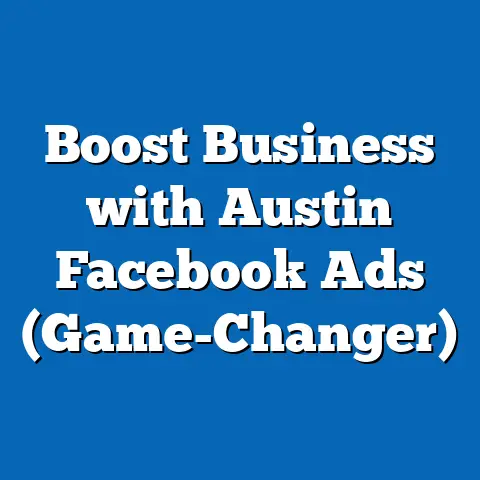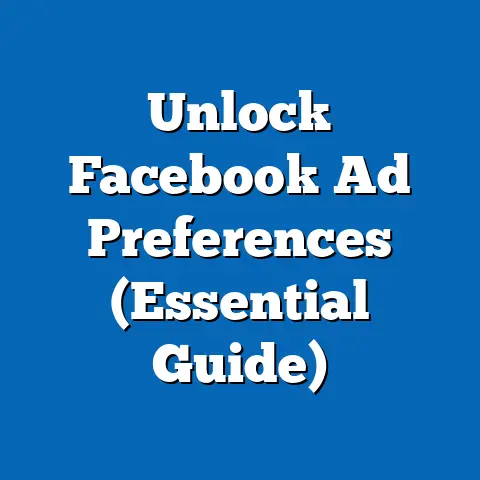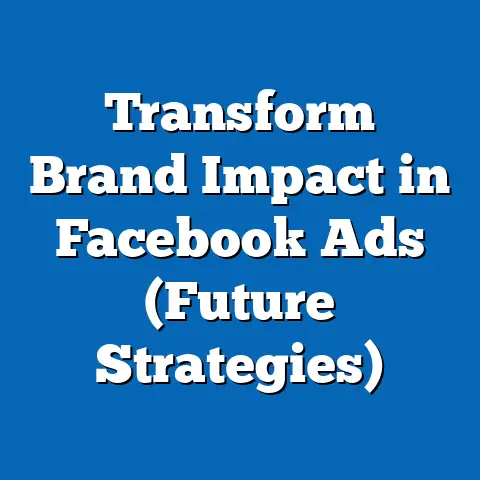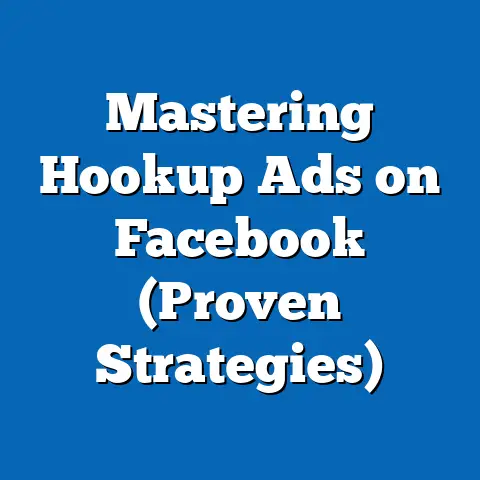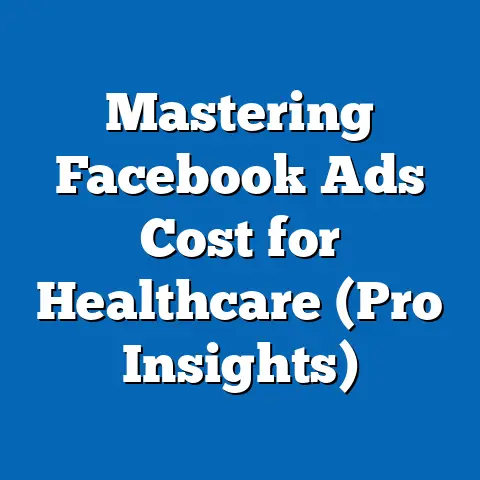Average CTR: Facebook Ads vs Google Search (Critical Insights)
Critical Insights: Analyzing Average Click-Through Rates (CTR) of Facebook Ads vs. Google Search
Introduction: A Shocking Disparity in Digital Advertising Effectiveness
In the realm of digital advertising, a staggering fact emerges: the average click-through rate (CTR) for Google Search ads stands at approximately 3.17% for the search network, while Facebook Ads hover at a much lower 0.90% across industries, according to 2023 data from WordStream and Hootsuite. This significant gap reflects not only differences in platform functionality but also the distinct demographic compositions, user behaviors, and engagement patterns of their respective audiences. Understanding these disparities is crucial for marketers aiming to optimize their advertising strategies, as the effectiveness of ad campaigns often hinges on aligning with the core beliefs, preferences, and behavioral tendencies of target demographics.
Google Search users, often characterized by a broad demographic spread but skewing toward older, more educated individuals (with 62% of users aged 25-54 and 55% holding a college degree, per Pew Research 2022), tend to exhibit intent-driven behavior, searching for specific information or solutions. In contrast, Facebook’s user base is younger and more diverse, with 70% of users aged 18-44 and a significant portion from lower-to-middle-income brackets (Statista 2023), often engaging passively with content in a social context rather than with transactional intent. These demographic and behavioral differences shape distinct “voting patterns” in the digital space—where “voting” equates to clicking on ads—and set the stage for a deeper analysis of how these platforms compare in driving user engagement.
Demographic Composition: Who Uses These Platforms?
Google Search Demographics
Google Search, as the dominant search engine with over 92% of global search market share (StatCounter 2023), appeals to a wide demographic spectrum. Data from Pew Research (2022) indicates that 83% of U.S. adults use Google Search regularly, with usage consistent across racial and ethnic groups (84% of White, 82% of Black, and 79% of Hispanic adults). Age-wise, while younger users (18-24) are highly active, the platform sees substantial engagement from those aged 25-54, who often use it for professional or problem-solving purposes.
Gender distribution is nearly even, with 51% male and 49% female users, and education levels trend higher, with 55% of users holding at least a bachelor’s degree. Income levels vary, but there’s a notable concentration among middle-to-high-income earners, with 60% of users earning over $50,000 annually (Statista 2022). This demographic profile suggests a user base with a pragmatic, goal-oriented approach to online activity, often seeking immediate answers or products.
Facebook Ads Demographics
Facebook, with 2.9 billion monthly active users globally as of 2023 (Meta Reports), has a younger and more socially oriented user base. According to Statista (2023), 70% of U.S. Facebook users are aged 18-44, with the 25-34 age group being the largest at 31%. The platform shows a slight female skew (54% female vs. 46% male) and a diverse racial makeup, with significant representation from Hispanic (44% of U.S. Hispanic adults use it daily) and Black (43%) communities compared to White users (36%).
Education levels are lower than Google’s user base, with only 38% holding a college degree, and income distribution tilts toward lower-to-middle brackets, with 52% earning less than $50,000 annually. This demographic composition points to a user base that prioritizes social connection over transactional intent, often engaging with content casually while scrolling through feeds. This distinction profoundly impacts how ads are received on the platform compared to Google Search.
Core Beliefs and Behavioral Values: Intent vs. Engagement
Google Search: Transactional Intent as a Core Driver
Google Search users are guided by a core belief in efficiency and relevance, valuing quick access to information or solutions. A 2022 study by Search Engine Journal found that 63% of clicks on Google Search ads occur when users are in a “purchase intent” phase, reflecting a mindset focused on immediate needs or decision-making. This behavior aligns with the platform’s design, which prioritizes relevance through keyword targeting and user search history.
The value placed on utility means users are more likely to “vote” with their clicks when an ad directly addresses their query. For instance, industries like insurance and legal services see higher CTRs (up to 6%) on Google Search due to the urgent, solution-driven nature of these searches (WordStream 2023). This intent-driven behavior sets Google users apart from more passive social media audiences.
Facebook Ads: Social Connection and Emotional Appeal
Facebook users, conversely, prioritize social interaction and entertainment, with 74% using the platform daily to connect with friends or consume content (Pew Research 2023). Their core belief centers on community and relatability, making emotional or visually engaging ads more effective. A 2022 report by Hootsuite notes that ads with strong storytelling or social proof (e.g., likes, shares) achieve up to 1.2% CTR on Facebook, compared to the 0.9% average.
This value system means clicks are often driven by curiosity or personal resonance rather than immediate need. For example, lifestyle and retail ads perform better on Facebook, capitalizing on impulse engagement rather than deliberate intent. This fundamental difference in user mindset explains much of the CTR disparity between the platforms.
“Voting Patterns” and Engagement: Clicking as a Political Act
Google Search: High Engagement Through Intent
In the digital “voting” landscape, Google Search users exhibit a higher propensity to engage with ads, reflected in the 3.17% average CTR across industries (WordStream 2023). This engagement peaks in sectors like finance (5.1% CTR) and education (4.2% CTR), where users actively seek specific services. The “voting pattern” here is deliberate—users click when ads match their search intent, with 65% of clicks on Google Search ads leading to conversions (Google Ads Insights 2022).
Engagement also correlates with demographic factors. Older users (35-54) and those with higher education levels show higher click rates, likely due to greater purchasing power and decision-making authority (Statista 2022). This targeted, purposeful “voting” behavior underscores Google’s strength in capturing high-intent audiences.
Facebook Ads: Lower Engagement with Broader Reach
Facebook Ads, with an average CTR of 0.90%, reflect a more passive “voting” pattern, where clicks are less frequent but reach a broader audience due to the platform’s 2.9 billion users (Hootsuite 2023). Engagement is highest among younger users (18-24), who click at rates up to 1.1%, often on entertainment or retail ads. However, conversion rates are lower, with only 30% of clicks leading to purchases compared to Google’s 65% (Meta Advertising Report 2022).
Demographic trends show that women and lower-income users are more likely to engage with ads, often driven by promotions or social trends (Statista 2023). This pattern indicates a less focused, more exploratory approach to “voting” with clicks, contrasting sharply with Google’s intent-driven engagement.
Policy Positions on Major Issues: Ad Targeting and User Experience
Google Search: Precision Targeting and Relevance
Google Search’s “policy position” on advertising hinges on precision and user relevance, leveraging search history, location, and keywords to deliver tailored ads. A 2023 Google Ads report states that 72% of users find search ads helpful when they match their query, contributing to higher CTRs. This focus on intent allows advertisers to target niche demographics effectively, such as professionals seeking B2B services (CTR of 4.5% in tech industries).
However, this approach can alienate users who feel overly tracked, with 41% expressing privacy concerns over personalized ads (Pew Research 2022). Google’s challenge lies in balancing relevance with user trust, a key area of internal debate within its advertising ecosystem.
Facebook Ads: Broad Targeting and Social Integration
Facebook’s advertising “policy” emphasizes broad reach and social integration, using demographic data, interests, and social connections to target users. A 2022 Meta report highlights that 68% of advertisers value Facebook’s ability to reach diverse audiences, even if CTRs are lower. This approach excels in brand awareness campaigns, with retail ads seeing impressions-to-click ratios of 100:1 (Hootsuite 2023).
Yet, Facebook faces criticism for ad fatigue, with 54% of users reporting irritation at repetitive or irrelevant ads (Statista 2023). The platform’s reliance on passive engagement also sparks division among advertisers, with some prioritizing reach over immediate clicks, while others seek higher conversion metrics.
Distinguishing Features: What Sets Them Apart?
Google Search: Intent-Driven Efficiency
Google Search stands out for its ability to capture high-intent users at critical decision-making moments. Its distinguishing feature is the alignment of ads with user queries, resulting in a 3.17% CTR that outpaces most digital platforms (WordStream 2023). Unlike social media, where engagement is incidental, Google’s strength lies in its transactional focus, making it indispensable for performance marketing.
This efficiency is particularly pronounced among older, educated demographics who value relevance over entertainment. Google’s ad ecosystem also benefits from integration with tools like Google Analytics, providing advertisers with granular data to refine campaigns—a feature less developed on social platforms.
Facebook Ads: Social Reach and Emotional Connection
Facebook Ads differentiate themselves through unparalleled social reach and the ability to foster emotional connections. With 2.9 billion users, the platform offers access to diverse demographics, particularly younger and socially active groups (Meta 2023). Its distinguishing feature is the integration of ads into social feeds, blending commercial content with personal interactions, though this often results in lower CTRs (0.9%).
Unlike Google, where intent drives clicks, Facebook capitalizes on impulse and relatability, making it ideal for brand-building rather than immediate conversions. This social-first approach sets it apart, even as it struggles with ad saturation and user skepticism.
Intersections with Demographic Factors: Age, Education, and Income
Age: Young vs. Mature Engagement
Age significantly influences engagement patterns on both platforms. On Google Search, users aged 35-54 show the highest CTRs (3.5%), driven by professional and financial needs, while younger users (18-24) click less frequently (2.8%) due to lower purchasing intent (Statista 2022). Conversely, Facebook sees peak engagement among 18-24-year-olds (1.1% CTR), with clicks declining among older users (0.7% for 45-54), reflecting a preference for social content over ads (Hootsuite 2023).
This age-based divergence highlights Google’s appeal to mature, decision-making audiences and Facebook’s strength among younger, exploratory users. Marketers must tailor content accordingly, focusing on utility for Google and relatability for Facebook.
Education and Income: Decision Power vs. Accessibility
Education and income levels further shape platform effectiveness. Google Search users with college degrees (55% of base) and incomes over $50,000 (60%) exhibit higher CTRs, reflecting greater decision-making power and intent (Pew Research 2022). On Facebook, lower education (38% with degrees) and income levels (52% under $50,000) correlate with more casual engagement, often driven by discounts or trends rather than deliberate purchases (Statista 2023).
These intersections suggest that Google excels in targeting affluent, educated demographics for high-value conversions, while Facebook offers accessibility to broader, less affluent audiences for mass-market campaigns. This dynamic is critical for budget allocation in advertising strategies.
Areas of Consensus and Division Within Platforms
Consensus: Value of Digital Advertising
Both platforms share a consensus on the importance of digital advertising as a driver of business growth. Advertisers on Google and Facebook agree that online ads are essential, with 78% of marketers using both platforms in tandem to balance intent and reach (eMarketer 2023). There’s also shared recognition of data-driven targeting as a cornerstone of effective campaigns, with both platforms offering robust analytics tools.
This alignment reflects a broader industry trend toward integrated digital strategies, where Google captures bottom-funnel conversions and Facebook builds top-funnel awareness. Such consensus drives investment in both ecosystems despite their differences.
Division: Metrics of Success
Divisions emerge in how success is measured. Google advertisers prioritize CTR and conversion rates, with 65% focusing on direct ROI metrics (Google Ads Report 2023). Facebook marketers, however, often value impressions and engagement over clicks, with 54% citing brand visibility as their primary goal (Meta 2022). This split creates internal debates over budget allocation and campaign objectives.
Additionally, user privacy concerns create friction, with Google facing scrutiny over search data usage and Facebook grappling with backlash over social profiling. These divisions highlight the complex trade-offs between effectiveness and ethics in digital advertising.
Historical and Social Context: Evolution of Digital Advertising
The disparity in CTR between Google Search and Facebook Ads must be understood within the historical evolution of digital advertising. Google Search, launched in 1998, pioneered intent-based advertising with AdWords in 2000, capitalizing on the internet’s growth as a problem-solving tool. Its focus on relevance and pay-per-click models set a high bar for CTR, aligning with a societal shift toward information-seeking behavior in the early 2000s (Google Historical Data).
Facebook, launched in 2004 with ads introduced in 2007, emerged during the social media boom, reflecting a cultural pivot toward connectivity and self-expression. Its lower CTR aligns with a societal preference for passive consumption over active searching, a trend amplified by mobile usage, which accounts for 98% of Facebook’s ad revenue (Meta 2023). This historical divergence—Google as a utility, Facebook as a social hub—continues to shape their advertising outcomes.
Broader social trends, such as growing privacy awareness and ad fatigue, also contextualize current CTR disparities. With 62% of users across platforms expressing distrust in personalized ads (Pew Research 2023), both Google and Facebook face challenges in maintaining engagement. This social context underscores the need for innovative, user-centric advertising approaches.
Patterns and Trends: Beyond Individual Campaigns
Focusing on broader patterns, Google Search consistently outperforms Facebook in CTR across industries, with a 3.17% average compared to 0.9% (WordStream 2023). This trend holds over time, with Google maintaining a 2-3x higher CTR since 2015, reflecting the enduring power of intent-driven advertising. Industries like finance and technology amplify this gap, with Google CTRs reaching 5-6% versus Facebook’s 1-1.5% (Hootsuite 2023).
Demographic trends also persist, with Google appealing to older, affluent users and Facebook retaining younger, diverse audiences. These patterns suggest that while individual campaigns may vary, the structural differences in platform purpose and user behavior create predictable outcomes. Marketers can leverage these trends to design hybrid strategies that maximize both reach and conversion.
Conclusion: Strategic Implications for Advertisers
The CTR disparity between Google Search (3.17%) and Facebook Ads (0.9%) encapsulates fundamental differences in demographic makeup, user intent, and engagement patterns. Google’s strength lies in capturing high-intent, often older and affluent users through precise targeting, while Facebook excels in reaching younger, diverse audiences with broad, emotionally resonant campaigns. These distinctions, supported by extensive demographic data and industry statistics, highlight the need for tailored advertising strategies that align with each platform’s unique user base and behavioral drivers.
By understanding these dynamics—demographic intersections, core values, and historical context—advertisers can optimize budgets and creative approaches to balance immediate conversions with long-term brand building. The digital advertising landscape, shaped by evolving user expectations and privacy concerns, demands such nuanced, data-driven decision-making. Ultimately, the choice between Google Search and Facebook Ads is not a binary one but a complementary strategy informed by the critical insights outlined in this analysis.

